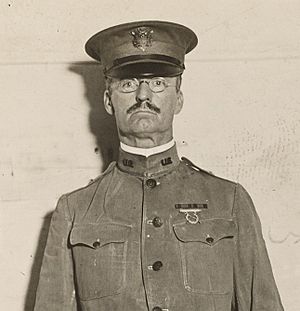Charles Aloysius Hedekin facts for kids
Quick facts for kids
Charles Hedekin
|
|
|---|---|

Brig. Gen. Charles Hedekin in September 1918
|
|
| Born | December 9, 1865 Fort Wayne, Indiana |
| Died | January 30, 1944 (aged 78) Washington, D.C. |
| Allegiance | |
| Service/ |
|
| Years of service | 1888–1920 |
| Rank | |
| Service number | 0-13487 |
| Spouse(s) | Adelaide Drew |
| Children | 2 |
Charles Aloysius Hedekin (December 9, 1865 – January 30, 1944) was an officer in the United States Army. He served in the Cavalry Branch during the late 1800s and early 1900s. Hedekin traveled and worked in many different places during his military career.
Contents
Early Life and Military Training
Charles Hedekin was born on December 9, 1865, in Fort Wayne, Indiana. When he was older, he attended the United States Military Academy. This is a famous school that trains future army officers. He graduated from West Point in 1888.
Serving the Nation: Early Career
After graduating, Hedekin joined the 3rd Cavalry Regiment. The cavalry were soldiers who rode horses.
Frontier Duty and Travel
From 1888 to 1895, Hedekin worked on the American frontier. This meant serving in areas that were still being settled. He also worked with the Intercontinental Railway Commission from March 1891 to May 1892. This job took him through Central America.
Protecting Borders and Overseas Service
Hedekin also served along the border with Mexico. This was during a time called the Garza Revolution. He was stationed at several military posts, including Jefferson Barracks Military Post, Fort Ethan Allen, Fort Sheridan, and Fort Myer.
Later, Hedekin was sent to the Philippines for two years. He returned in 1902. After that, he served at Fort Apache, Arizona. He went back to the Philippines again from 1906 to 1908, serving at Fort Stotsenburg. When he came back to the United States, his regiment was stationed in Texas, at Fort Sam Houston and Fort Clark, Texas.
Advancing in Rank and New Roles
On September 3, 1911, Charles Hedekin was promoted to the rank of major. He then joined the 15th Cavalry Regiment and led its Second Squadron.
Further Military Education
Major Hedekin continued his education to become a better officer. He completed a special course for field officers at Fort Leavenworth. He also graduated from the Mounted Service School at Fort Riley. In 1912, he graduated from the United States Army War College. These schools helped him learn more about military strategy and leadership.
Helping Americans in Europe
Hedekin worked with the Militia Division of the United States Department of War. From August to October 1914, he helped rescue American tourists who were stranded in Europe.
Commanding Regiments
In 1916, he went with the 4th Cavalry Regiment to the Schofield Barracks. In July 1917, he took command of the 13th Cavalry Regiment at Fort Riley. He led this regiment to the border with Mexico. However, he was soon called back to Washington, D.C.
Becoming a General and Retirement
On June 26, 1918, Charles Hedekin was promoted to brigadier general. This is a very high rank in the army.
Leading Troops
As a brigadier general, he commanded the 155th Depot Brigade. He also oversaw new soldiers at Camp Lee. In October 1919, he commanded the 15th Cavalry Regiment. Later, he led the 7th Cavalry Regiment at Fort Bliss. General Hedekin retired from the army on August 5, 1920.
Life After the Army
After retiring, General Hedekin and his family moved to Bethesda, Maryland. They lived there for seven years. In 1930, they sold their house to travel in Europe. However, they had to return to the U.S. in 1931 because General Hedekin became ill.
He spent four months at the Walter Reed Army Medical Center. After he recovered, he and his family went back to Europe. They stayed there until October 1933.
General Charles Hedekin passed away in Washington, D.C., on January 30, 1944. He was buried at Arlington National Cemetery, a special place where many brave service members are laid to rest.

